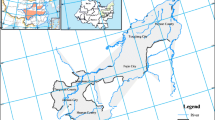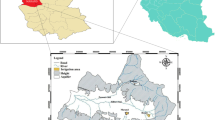Abstract
A simulation-based inexact rough-interval programming approach is proposed for agricultural irrigation management in a China’s rural region. The conjunctive use of multiple water sources is examined under a set of land-area, water-availability, environmental-standard, capital, and technical constraints. The formulated model presents capability in interpreting implication of various water-supply means on agricultural water-allocation plans, as well as handling highly-uncertain parameters existing in many real-world practices. A case study in the central-south China demonstrates the applicability of the proposed model. The modelling inputs of economy-related parameters are identified as conventional intervals based on the statistical data, while those of water availability are characterized as rough intervals by converting the predicted values from a distributed hydrological model. Scenarios of groundwater supplementation rates being 0, 20, 30 and 40 %, respectively are considered to generate optimal irrigation plans. Reasonable results are obtained, which are then used to analyze the impact of water-supplier variation on planning sustainable development strategies.







Similar content being viewed by others
Abbreviations
- A ℝ, B ℝ :
-
two sets of rough intervals, and \( {A^{\mathbb{R}}} \in {R^{{\mathbb{R}\left( {m \times n} \right)}}} \) and \( {B^{\mathbb{R}}} \in {R^{{\mathbb{R}\left( {m \times n} \right)}}} \)
- C ±∈{Π}p and Π :
-
denotes a set of interval parameters
- X ℝ :
-
a set of decision variables
- f ℝ :
-
denotes objective function value
- SNB ℝ :
-
system net benefit (¥)
- \( U{B_j}^{\pm } \) :
-
unit benefit for crop j ($/ha)
- \( CROPA_{{ijt}}^{\mathbb{R}} \) :
-
allocated crop area for crop j in zone i at time t (ha)
- USWC ± :
-
unit surface water cost for delivering ($/tonne)
- \( SW{S_{{ijt}}}^{\mathbb{R}} \) :
-
allocated surface water amount for crop j in zone i at time t (tonne)
- UGWC ± :
-
unit groundwater cost for pumping and delivering ($/tonne)
- \( GW{S_{{ijt}}}^{\mathbb{R}} \) :
-
allocated groundwater amount for crop j in zone i at time t (tonne)
- i :
-
index of agricultural zones
- j :
-
index of crops
- t :
-
index of planning horizon
- I, J, T :
-
total number of zones, types of crops, and planning periods
- \( SW{A_t}^{\Re } \) :
-
surface water availability in period t (m3)
- \( GW{A_t}^{\Re } \) :
-
groundwater availability in period t (m3)
- RPSW t :
-
defined rate of surface water use
- RPGW t :
-
defined rate of groundwater use, equal to (1 − RPSW t )
- PR ℜ :
-
precipitation (mm)
- IF ℜ :
-
inflow (mm)
- RC ℜ :
-
recharge (mm)
- AET ℜ :
-
actual evaportranspiration (mm), which is function of precipitation, temperature, and solar radiation
- OF ℜ :
-
outflow (mm)
- IN ℜ :
-
inflow of the aquifer (mm)
- ES ℜ :
-
evaporation of the aquifer (mm)
- OUT ℜ :
-
outflow of the aquifer (mm)
- \( UWD_{{jt}}^{\pm } \) :
-
unit water demand for irrigating crop j in period t (m3/ha)
- ESWU ± :
-
efficiency of surface water use
- EGWU ± :
-
efficiency of groundwater use
- TCWU ± :
-
maximum investment for water allocation over the planning horizon (¥)
- ALA t :
-
maximum allowable area for planting crops in period t (ha)
- RLA t :
-
minimum allowable area for planting crops in period t (ha)
- \( RCROPA_{{ijt}}^{\pm } \) :
-
is regulated minimum area for planting crop j in zone i in period t (ha)
- \( UNL_{{ij}}^{\pm } \) :
-
unit nitrogen loss (tonne/ha)
- \( ATND_t^{\pm } \) :
-
allowable maximum total nitrogen discharge (tonne)
- \( UPL_{{ij}}^{\pm } \) :
-
unit phosphorous loss (tonne/ha)
- \( TPD_t^{\pm } \) :
-
allowable maximum total phosphorous discharge (tonne)
- \( UPCL_{{ij}}^{\pm } \) :
-
unit pesticide loss (tonne/ha)
- \( ATPCD_{{it}}^{\pm } \) :
-
allowable maximum total pesticide discharge (tonne).
References
Cong ZT, Yang DW, Gao B et al (2009) Hydrological trend analysis in the Yellow River basin using a distributed hydrological model. Water Resour Res 45: Article no. W00A13.
Edossa DC, Babel MS (2011) Application of ANN-based streamflow forecasting model for agricultural water management in the Awash River Basin, Ethiopia. Water Resour Manag 25(6):1759–1773
Gaiser T, Printz A, von Raumer HGS et al (2008) Development of a regional model for integrated management of water resources at the basin scale. Phys Chem Earth 33(1–2):175–182
Guo P, Huang GH, He L et al (2009) Interval-parameter two-stage stochastic semi-infinite programming: application to water resources management under uncertainty. Water Resour Manag 23(5):1001–1023
He L, Huang GH, Lu HW (2008) A simulation-based fuzzy chance-constrained programming model for optimal groundwater remediation under uncertainty. Adv Water Resour 31(12):1622–1635
He L, Huang GH, Lu HW (2009) Flexible interval mixed-integer bi-infinite programming for environmental systems management under uncertainty. J Environ Manage 90(5):1802–1813
He L, Huang GH, Lu HW (2010) A stochastic optimization model under modeling uncertainty and parameter certainty for groundwater remediation design-Part I. Model development. J Hazard Mater 176(1–3):521–526
He L, Huang GH, Lu HW (2011) Characterization of petroleum-hydrocarbon fate and transport in homogeneous and heterogeneous aquifers using a generalized uncertainty estimation method. J Environ Eng-ASCE 137(1):1–8, 2011
Hincal O, Altan-Sakarya AB, Ger AM (2011) Optimization of multireservoir systems by genetic algorithm. Water Resour Manag 25(5):1465–1487
Huang GH, Loucks DP (2000) An inexact two-stage stochastic programming model for water resources management under uncertainty. Civ Eng Environ Syst 17:95–118
Huang GH, Chen B, Mance E et al (2006) An integrated decision support system for rural economic and eco-environmental sustainability in Shanjianghu Region. Jiangxi, China. UNDP report.
Liu ZF, Huang GH, Liao RF et al (2009) DIPIT: Dual interval probabilistic integer programming for solid waste management. J Environ Inform 14(1):66–73
Loucks DP (2000) Sustainable water resources management. Water Int 25(1):3–10
Lu HW, Huang GH, Maqsood I et al (2008) An inexact two-stage fuzzy-stochastic programming model for water resources management. Water Resour Manag 22(8):991–1016
Lu HW, Huang GH, He L (2009) A two-step infinite α-cuts fuzzy linear programming method in determination of optimal allocation strategies in agricultural irrigation systems. Water Resour Manag 23(11):2249–2269
Lu HW, Huang GH, He L (2011) An inexact rough-interval fuzzy linear programming method for generating conjunctive water-allocation strategies to agricultural irrigation systems. App Math Model 35:4330–4340
Lu HW, Huang GH, He L et al (2012) Strategic agricultural land-use planning in response to water-supplier variation in a China’s rural region. Agr Syst 108:19–28
Mance E (2007) Inexact two-stage water quality management model for the He River Basin in Yongxin County, University of Regina, Master Thesis.
Prinz D, Singh AK (2000) Water resources in arid regions and their sustainable management. Ann Arid Zone 39(3):251–271
Qin XS, Huang GH (2009) An inexact chance-constrained quadratic programming model for stream water quality management. Water Resour Manag 23(4):661–695
Regulwar DG, Gurav JB (2011) Irrigation planning under uncertainty-a multi objective fuzzy linear programming approach. Water Resour Manag 25(5):1387–1416
Soulis K, Dercas N (2007) Development of a GIS-based spatially distributed continuous hydrological model and its first application. Water Int 32(1):177–192
Wang L, Meng W, Guo HC et al (2006) An interval fuzzy multiobjective watershed management model for the Lake Qionghai Watershed, China. Water Resour Manag 20(5):701–721
Xu CY, Vandewiele GL (1995) Parsimonious monthly rainfall-runoff models for humid basins with different input requirements. Adv Water Resour 18(1):39–48
Yang ZF, Sun T, Qin XS (2005) Calculating methods for quantifying environmental flows in estuaries: a case study of Haihe River Basin, China. J Environ Inform 6(2):72–79
Yao JT, Liu WN, Fan L et al (2006) Supporting sustainable communities with web-based information systems. J Environ Inform 7(2):84–94
Acknowledgments
This research was supported by the National Natural Science Foundation of China (Grant No. 51222906 and 41271540), and, the Fundamental Research Funds for the Central Universities. The authors are grateful to the editor and the anonymous reviewers for their insightful comments and suggestions.
Author information
Authors and Affiliations
Corresponding author
Rights and permissions
About this article
Cite this article
Lu, H.W., Huang, G.H. & He, L. Simulation-Based Inexact Rough-Interval Programming for Agricultural Irrigation Management: A Case Study in the Yongxin County, China. Water Resour Manage 26, 4163–4182 (2012). https://doi.org/10.1007/s11269-012-0138-6
Received:
Accepted:
Published:
Issue Date:
DOI: https://doi.org/10.1007/s11269-012-0138-6




